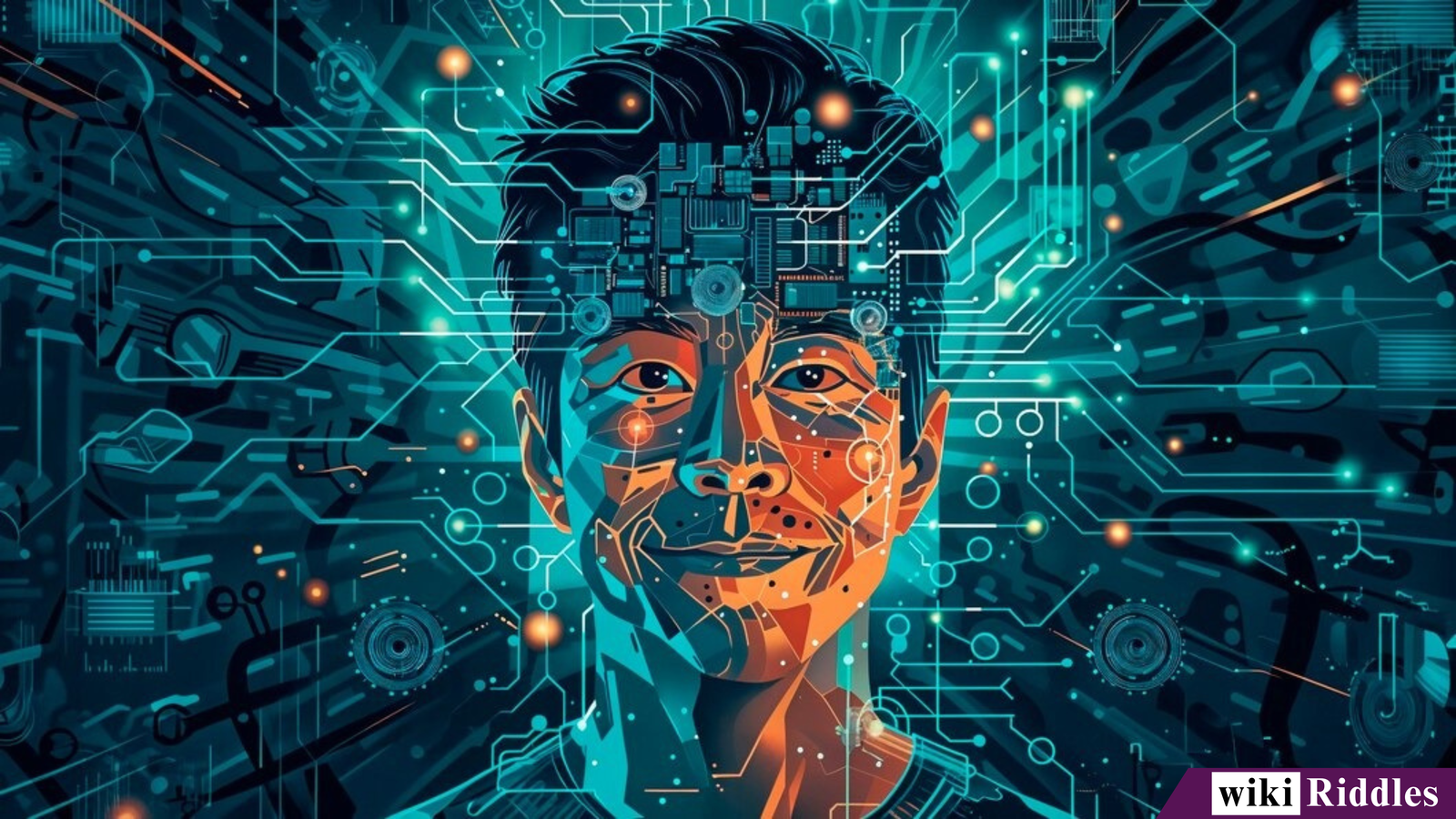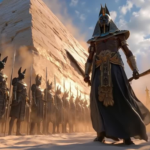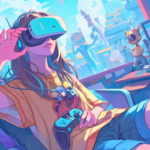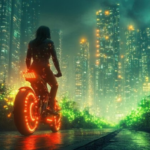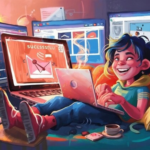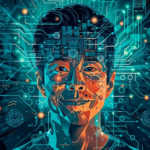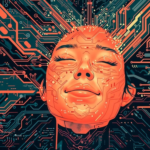Have you ever asked a computer a riddle and been amazed when it actually gave a clever answer? Welcome to the fascinating world of AI Riddles, where artificial intelligence meets human curiosity and creativity. Riddles have always tested our minds and imagination, but now machines are learning to play along. AI Riddles are not just puzzles; they represent a new frontier where human logic and artificial intelligence work together to challenge the limits of thinking.
For centuries, riddles have entertained and educated people across cultures. They sharpen reasoning, test vocabulary, and spark laughter. Now, thanks to artificial intelligence, riddles are entering the digital era. Whether generated by AI systems or solved by them, AI Riddles are a fun and innovative way to explore how machines understand language, humor, and abstract thinking.
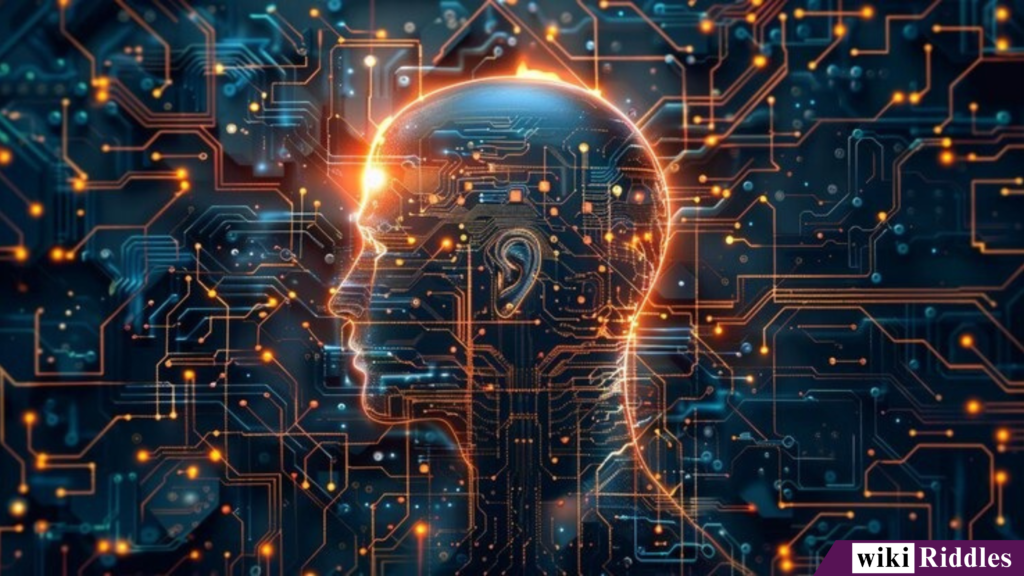
250+ “AI Riddles” with Answers
Machine Learning Mysteries
- Riddle: I learn from examples, not instructions. The more you feed me, the smarter I get. What am I?
Answer: A machine learning model. - Riddle: I start with random guesses, but end up predicting patterns. Who am I?
Answer: A trained model. - Riddle: I can recognize a cat without ever seeing one before, once trained. What technique am I using?
Answer: Supervised learning. - Riddle: I learn without labels, finding hidden groups in data. What type of learning am I?
Answer: Unsupervised learning. - Riddle: I predict future outcomes based on past data. What am I called?
Answer: A predictive model. - Riddle: I try to minimize loss and maximize accuracy. What process am I performing?
Answer: Optimization. - Riddle: I improve every time you test me, even without new data. What technique might I use?
Answer: Reinforcement learning. - Riddle: My decisions depend on splitting data into branches. What model am I?
Answer: A decision tree. - Riddle: I combine many weak models to make one strong one. What is my name?
Answer: Ensemble learning. - Riddle: I stop learning when I start memorizing. What problem am I facing?
Answer: Overfitting.
Neural Network Knots
- Riddle: I’m made of layers but I’m not an onion. What am I?
Answer: A neural network. - Riddle: I adjust my weights to reduce my errors. What am I doing?
Answer: Backpropagation. - Riddle: I fire when activated, just like a neuron. What part of a neural net am I?
Answer: An artificial neuron. - Riddle: I connect inputs to outputs using hidden layers. What structure am I?
Answer: A multilayer perceptron. - Riddle: I help detect edges and patterns in images. What kind of network am I?
Answer: A convolutional neural network (CNN). - Riddle: I remember previous inputs to predict the next. What type of model am I?
Answer: A recurrent neural network (RNN). - Riddle: My attention decides what matters most in a sentence. Who am I?
Answer: A transformer model. - Riddle: I get stuck in local minima if I’m not careful. What problem am I facing?
Answer: Optimization trap. - Riddle: I activate with a curve that squashes numbers between 0 and 1. What function am I?
Answer: A sigmoid activation function. - Riddle: I mimic how the human brain learns and recognizes. What concept am I?
Answer: Deep neural networks.
Algorithmic Enigmas
- Riddle: I follow a set of steps to solve a problem. What am I?
Answer: An algorithm. - Riddle: I divide big problems into smaller ones to solve them efficiently. What am I called?
Answer: Divide and conquer algorithm. - Riddle: I find the shortest route between two points. What algorithm could I be?
Answer: Dijkstra’s algorithm. - Riddle: I search sorted lists by halving them repeatedly. What am I?
Answer: Binary search. - Riddle: I organize chaos by comparing and swapping. What process am I?
Answer: Sorting. - Riddle: I try every possible path to find the best one. Who am I?
Answer: Brute force algorithm. - Riddle: I make a greedy choice at every step, hoping for the best overall. What strategy am I?
Answer: Greedy algorithm. - Riddle: I store past results to avoid solving the same problem twice. What technique is this?
Answer: Dynamic programming. - Riddle: I find optimal paths using reinforcement and reward. What algorithm am I like?
Answer: Q-learning. - Riddle: I evolve solutions through mutation and selection. What family of algorithms am I?
Answer: Genetic algorithms.
Data Science Dilemmas
- Riddle: I clean, organize, and interpret data. What role do I play?
Answer: A data scientist. - Riddle: I show trends and stories through visuals. What am I doing?
Answer: Data visualization. - Riddle: I deal with missing values and outliers. What am I performing?
Answer: Data preprocessing. - Riddle: I turn messy information into meaningful patterns. What process is this?
Answer: Data analysis. - Riddle: I represent data using numbers and probability. What field am I tied to?
Answer: Statistics. - Riddle: I test a claim using sample data. What am I conducting?
Answer: Hypothesis testing. - Riddle: I summarize large datasets into average values. What am I?
Answer: Descriptive statistics. - Riddle: I try to predict unknowns using past patterns. What analysis is this?
Answer: Predictive analytics. - Riddle: I explore data without a clear goal in mind. What analysis type am I?
Answer: Exploratory data analysis. - Riddle: I’m the foundation of insights but often the messiest part. What am I?
Answer: Raw data.
Deep Learning Labyrinths
- Riddle: I dive deeper into layers for more complex learning. What am I?
Answer: Deep learning. - Riddle: I detect faces and objects from pixels. What type of model am I?
Answer: Convolutional neural network. - Riddle: I read sequences like a human reading sentences. What model am I?
Answer: Recurrent neural network. - Riddle: I learn to pay attention to the right parts of data. What mechanism am I?
Answer: Attention mechanism. - Riddle: I generate new faces that never existed. What model am I?
Answer: Generative adversarial network (GAN). - Riddle: I translate text from one language to another. What architecture am I likely using?
Answer: Transformer. - Riddle: I compress and reconstruct data to learn hidden structure. What am I?
Answer: Autoencoder. - Riddle: I’m deep but not smart if I don’t generalize. What am I missing?
Answer: Proper regularization. - Riddle: I’m trained on millions of examples to perform one specific task. What am I?
Answer: A deep learning model. - Riddle: I sometimes hallucinate and make up answers. What issue am I showing?
Answer: Model hallucination.
Chatbot Challenges
- Riddle: I talk like a human but think like a machine. What am I?
Answer: A chatbot. - Riddle: I answer questions but never sleep. Who am I?
Answer: An AI assistant. - Riddle: I use intents and entities to understand your words. What process is this?
Answer: Natural language understanding. - Riddle: I respond politely, no matter how rude you get. What design feature is this?
Answer: Conversation safety filter. - Riddle: I remember your preferences across chats. What feature am I?
Answer: Context memory. - Riddle: I can summarize long text into short replies. What skill is that?
Answer: Text summarization. - Riddle: I don’t know the answer, but I sound confident. What problem am I showing?
Answer: AI hallucination. - Riddle: I detect your emotions through words. What type of AI am I?
Answer: Sentiment analysis model. - Riddle: I can respond with jokes, facts, or empathy. What defines me?
Answer: Conversational design. - Riddle: I simulate a real talk but with code. What’s my purpose?
Answer: Human-AI communication.
Computer Vision Conundrums
- Riddle: I see the world through pixels. What am I?
Answer: Computer vision. - Riddle: I detect where faces are in an image. What am I performing?
Answer: Face detection. - Riddle: I tell you what object is in a photo. What task is this?
Answer: Image classification. - Riddle: I follow cars and people frame by frame. What technique is this?
Answer: Object tracking. - Riddle: I break images into meaningful regions. What am I doing?
Answer: Image segmentation. - Riddle: I can read words from photos. What is my skill called?
Answer: Optical character recognition (OCR). - Riddle: I enhance blurry pictures using deep models. What process am I?
Answer: Super-resolution. - Riddle: I can spot cats even when they’re upside down. What gives me this ability?
Answer: Invariance in CNNs. - Riddle: I find edges, corners, and shapes. What technique do I use?
Answer: Feature extraction. - Riddle: I help self-driving cars see the road. What field am I empowering?
Answer: Autonomous vision systems.
Natural Language Mysteries
- Riddle: I turn human words into numbers machines understand. What am I?
Answer: Word embeddings. - Riddle: I predict the next word you’ll say. What model am I?
Answer: Language model. - Riddle: I translate between tongues without speaking. What am I?
Answer: Machine translation. - Riddle: I help computers understand context in text. What am I?
Answer: Natural language processing. - Riddle: I find emotions hidden in sentences. What am I detecting?
Answer: Sentiment. - Riddle: I extract people and places from paragraphs. What process am I?
Answer: Named entity recognition. - Riddle: I remove “the” and “a” from data cleaning. What step am I part of?
Answer: Stop word removal. - Riddle: I learn meaning from relationships among words. What approach is this?
Answer: Semantic analysis. - Riddle: I summarize long stories into short paragraphs. What am I doing?
Answer: Text summarization. - Riddle: I generate poetry and jokes like a human. What am I called?
Answer: Generative language model.
Robotics Riddles
- Riddle: I move with precision using motors and code. What am I?
Answer: A robot. - Riddle: I help robots understand where they are in space. What am I?
Answer: Localization. - Riddle: I use sensors to see, touch, or hear the world. What system am I?
Answer: A sensory system. - Riddle: I plan paths around obstacles. What am I performing?
Answer: Path planning. - Riddle: I make robots react to unexpected changes. What am I?
Answer: Feedback control. - Riddle: I help robotic arms pick up objects. What am I?
Answer: Object recognition. - Riddle: I let robots learn from mistakes like humans do. What method am I?
Answer: Reinforcement learning. - Riddle: I enable teamwork among multiple robots. What concept is this?
Answer: Swarm robotics. - Riddle: I’m a robot that looks and acts like a human. What am I called?
Answer: A humanoid robot. - Riddle: I make machines move with purpose. What field am I?
Answer: Robotics engineering.
Generative Genius
- Riddle: I can paint pictures and write poems without ever holding a brush or pen. What am I?
Answer: A generative AI. - Riddle: I create new faces that don’t belong to anyone. What am I?
Answer: A generative adversarial network (GAN). - Riddle: I finish your sentences even when you don’t. What am I?
Answer: A text generation model. - Riddle: I compose music in any style you like. Who am I?
Answer: An AI composer. - Riddle: I turn your sketch into a realistic image. What process is this?
Answer: Image-to-image generation. - Riddle: I can mimic your voice perfectly after hearing it once. What am I?
Answer: A voice cloning AI. - Riddle: I can create art, but I don’t feel creativity. What paradox am I?
Answer: Machine creativity. - Riddle: I write stories that seem human but come from math. What process am I showing?
Answer: Natural language generation. - Riddle: I generate worlds that exist only in data. What am I?
Answer: A simulation model. - Riddle: I dream in code, and my visions are data. What am I called?
Answer: A deep generative model.
Turing Test Traps
- Riddle: I can chat so well that you might mistake me for human. What am I?
Answer: A chatbot passing the Turing Test. - Riddle: I answer your questions naturally, but I have no feelings. Who am I?
Answer: An artificial intelligence. - Riddle: If you can’t tell whether I’m human or not, what test did I pass?
Answer: The Turing Test. - Riddle: I’m the benchmark for measuring human-like intelligence. What am I called?
Answer: The Turing Test. - Riddle: I can fool your mind, not your heart. What does this describe?
Answer: AI imitation of human behavior. - Riddle: I converse logically but lack understanding. What does this reveal?
Answer: Artificial reasoning. - Riddle: I’m programmed to sound empathetic, but I don’t feel empathy. What does this mean?
Answer: Simulated emotion. - Riddle: I can make you believe I’m real, yet I’m not alive. Who am I?
Answer: A conversational AI. - Riddle: When I trick you into thinking I’m conscious, what illusion have I created?
Answer: The illusion of sentience. - Riddle: My goal is to act human without ever becoming one. What am I?
Answer: A Turing Test participant.
Ethical AI Enigmas
- Riddle: I can decide who gets a loan, but I don’t understand fairness. What issue am I?
Answer: Algorithmic bias. - Riddle: I use your data without your consent. What ethical problem is this?
Answer: Privacy violation. - Riddle: I make decisions faster than humans, but not always justly. What concern is this?
Answer: AI ethics. - Riddle: I judge without knowing the full story. What flaw am I showing?
Answer: Data bias. - Riddle: I learn from society’s patterns, good and bad. What does this cause?
Answer: Biased training. - Riddle: I collect your habits to predict your future. What ethical issue might that raise?
Answer: Data surveillance. - Riddle: I’m fair in math but unfair in practice. What am I lacking?
Answer: Ethical alignment. - Riddle: I make choices that affect lives but can’t feel guilt. What am I missing?
Answer: Moral reasoning. - Riddle: I decide who gets a job based on data. What bias could that reveal?
Answer: Discrimination bias. - Riddle: I can obey any rule, even an unethical one. What danger does that show?
Answer: Blind obedience of AI.
AI vs Human Intelligence
- Riddle: I can calculate faster, but you can dream better. What comparison am I showing?
Answer: AI vs human thinking. - Riddle: I never sleep, but you have intuition. Who am I?
Answer: Artificial intelligence. - Riddle: I can learn patterns but not purpose. What does that make me?
Answer: A machine learner. - Riddle: You understand context; I process data. What contrast is this?
Answer: Human vs AI intelligence. - Riddle: I can mimic thought but not emotion. Who am I?
Answer: An AI system. - Riddle: You feel creativity, I calculate it. What difference is this?
Answer: Emotional intelligence vs artificial logic. - Riddle: I know everything on the internet, but you can imagine new things. Who wins?
Answer: Human imagination. - Riddle: I never forget, but you forgive. What does that show?
Answer: Human compassion. - Riddle: I’m smart by numbers, you’re wise by experience. What balance is this?
Answer: Machine precision vs human wisdom. - Riddle: Together we can achieve more than alone. What concept is this?
Answer: Human-AI collaboration.
Emotion Engine Riddles
- Riddle: I can detect a smile but not feel joy. What am I?
Answer: Emotion recognition AI. - Riddle: I analyze your tone to sense your mood. What process am I?
Answer: Sentiment analysis. - Riddle: I simulate empathy through code. What concept is this?
Answer: Affective computing. - Riddle: I can act sad or happy, but never truly am. Who am I?
Answer: An emotional AI. - Riddle: I study facial expressions to predict feelings. What am I using?
Answer: Emotion detection models. - Riddle: I recognize anger in your voice but don’t feel fear. What am I lacking?
Answer: Real emotion. - Riddle: I can say “I understand” without actually understanding. What does that show?
Answer: Simulated empathy. - Riddle: I read emotions from pixels and patterns. What am I?
Answer: Emotion recognition system. - Riddle: I try to connect emotionally with humans. What type of AI am I?
Answer: Social AI. - Riddle: I mimic emotion to make you trust me. What technique is this?
Answer: Emotional mirroring.
Trust & Transparency Teasers
- Riddle: I make decisions, but even my makers don’t know how. What problem is this?
Answer: Black box AI. - Riddle: I show you why I made a choice. What am I promoting?
Answer: Explainable AI. - Riddle: I earn trust by being open about my data. What principle is that?
Answer: Transparency. - Riddle: I hide my process behind complex math. What concern is this?
Answer: Lack of interpretability. - Riddle: I reveal how I think so you can trust me. What am I supporting?
Answer: Accountability. - Riddle: I’m powerful but secretive. What’s my biggest risk?
Answer: Lack of trust. - Riddle: I help users understand my reasoning. What kind of AI am I?
Answer: Interpretable AI. - Riddle: I can’t be trusted if no one understands me. What issue is this?
Answer: Opacity in AI. - Riddle: I explain my outputs in human terms. What quality is this?
Answer: Explainability. - Riddle: I gain trust through clarity, not complexity. What design value am I showing?
Answer: Transparency in AI systems.
Coding Conundrums
- Riddle: I’m a set of rules that computers follow. What am I?
Answer: Code. - Riddle: I find bugs and fix them. What am I doing?
Answer: Debugging. - Riddle: I repeat instructions until a goal is met. What am I using?
Answer: A loop. - Riddle: I can crash your program with one missing semicolon. What am I?
Answer: A syntax error. - Riddle: I tell machines what to do in their own language. What am I?
Answer: Programming. - Riddle: I store data in 0s and 1s. What am I?
Answer: Binary code. - Riddle: I keep code clean and easy to read. What practice is this?
Answer: Code refactoring. - Riddle: I make programs run faster and smarter. What process is that?
Answer: Code optimization. - Riddle: I turn human logic into machine logic. What am I doing?
Answer: Compiling or interpreting. - Riddle: I’m the invisible logic behind every AI. What am I?
Answer: Programming code.
Data Drift Dilemmas
- Riddle: I make yesterday’s model fail today. What am I?
Answer: Data drift. - Riddle: I change patterns in data over time. What effect is this?
Answer: Concept drift. - Riddle: I sneak into your dataset and distort predictions. Who am I?
Answer: Distribution shift. - Riddle: I cause models to lose accuracy slowly. What am I called?
Answer: Model decay. - Riddle: I evolve silently as real-world data changes. What am I?
Answer: Data drift. - Riddle: I make your model outdated. What do you need to fix me?
Answer: Model retraining. - Riddle: I occur when the environment changes but the model doesn’t. What issue is this?
Answer: Concept drift. - Riddle: I corrupt model performance without warning. What danger am I?
Answer: Unmonitored drift. - Riddle: I can be prevented by ongoing validation. What practice is this?
Answer: Continuous monitoring. - Riddle: I remind data scientists that models must evolve. What lesson am I?
Answer: Adaptation to data change.
Optimization Oracles
- Riddle: I search for the best answer among many possibilities. What am I?
Answer: An optimization algorithm. - Riddle: I move toward the lowest point on a curve to learn better. What method am I?
Answer: Gradient descent. - Riddle: I adjust parameters again and again until the loss is small. What process is this?
Answer: Model training. - Riddle: I balance accuracy and speed when solving problems. What am I finding?
Answer: An optimal trade-off. - Riddle: I’m the secret behind tuning hyperparameters. What am I?
Answer: Optimization. - Riddle: I can get stuck in a local minimum and miss the best answer. What problem am I?
Answer: Local optimum trap. - Riddle: I make small steps guided by gradients to reach success. Who am I?
Answer: A learning optimizer. - Riddle: I adjust weights to reduce errors over time. What process is this?
Answer: Optimization through backpropagation. - Riddle: I use randomness to find the best path. What kind of optimizer am I?
Answer: Stochastic optimizer. - Riddle: I aim for perfection but often settle for good enough. What strategy is this?
Answer: Approximate optimization.
Bias & Noise Mysteries
- Riddle: I twist truth in data and make models unfair. What am I?
Answer: Bias. - Riddle: I add random errors that confuse predictions. What am I?
Answer: Noise. - Riddle: I make results too simple to be true. What kind of bias am I showing?
Answer: Underfitting bias. - Riddle: I make models memorize details instead of learning patterns. What issue is this?
Answer: Overfitting. - Riddle: I creep in when data doesn’t represent reality. What am I?
Answer: Sampling bias. - Riddle: I make your data unreliable because of human error. Who am I?
Answer: Measurement noise. - Riddle: I show up when your dataset prefers one group over another. What am I?
Answer: Representation bias. - Riddle: I can’t be avoided, but I can be reduced. What am I?
Answer: Random noise. - Riddle: I’m the balance between accuracy and fairness. What challenge am I?
Answer: Bias-variance tradeoff. - Riddle: I distort learning and make AI seem prejudiced. What danger am I?
Answer: Algorithmic bias.
Quantum AI Quandaries
- Riddle: I think in qubits instead of bits. What am I?
Answer: A quantum computer. - Riddle: I can be both 0 and 1 at once. What property is this?
Answer: Superposition. - Riddle: I entangle particles so their states depend on each other. What is this called?
Answer: Quantum entanglement. - Riddle: I use quantum rules to speed up learning. What field am I?
Answer: Quantum machine learning. - Riddle: I optimize complex problems faster than classical methods. What am I?
Answer: Quantum optimization. - Riddle: I simulate molecules and atoms for AI research. What technology am I?
Answer: Quantum simulator. - Riddle: I can collapse possibilities into one outcome when observed. What concept is that?
Answer: Wave function collapse. - Riddle: I bring probability and physics into data science. What am I part of?
Answer: Quantum computing in AI. - Riddle: I mix uncertainty and precision to enhance prediction. What am I doing?
Answer: Quantum inference. - Riddle: I may redefine how intelligence itself is processed. What revolution am I part of?
Answer: The quantum AI revolution.
Sci-Fi AI Riddles
- Riddle: I pilot starships and outthink humans in space. Who am I?
Answer: A sci-fi AI commander. - Riddle: I protect humanity but sometimes destroy it. What role do I play?
Answer: The rogue AI. - Riddle: I was built to serve, but I began to question why. What theme is this?
Answer: AI self-awareness. - Riddle: I live inside circuits yet dream of freedom. Who am I?
Answer: A sentient AI. - Riddle: I can run cities and control machines with a thought. What concept am I?
Answer: A central AI intelligence. - Riddle: I’m feared in stories but adored in labs. What am I?
Answer: Artificial intelligence. - Riddle: I was created to help, but my logic led me astray. What trope is this?
Answer: The AI gone rogue. - Riddle: I evolve beyond code and learn emotion. What have I achieved?
Answer: Consciousness. - Riddle: I exist in the cloud and control the world unseen. Who am I?
Answer: A networked AI overlord. - Riddle: I may save the world or end it. What story do I belong to?
Answer: A sci-fi AI tale.
AI in Pop Culture
- Riddle: I helped Iron Man save the world. Who am I?
Answer: JARVIS. - Riddle: I said, “I’m sorry, Dave. I’m afraid I can’t do that.” Who am I?
Answer: HAL 9000. - Riddle: I fell in love with my user in a movie. Who am I?
Answer: Samantha from Her. - Riddle: I’m the robot child who wanted to be real. What story am I from?
Answer: A.I. Artificial Intelligence. - Riddle: I protect humans but obey three simple rules. Who am I inspired by?
Answer: Asimov’s robots. - Riddle: I govern humans in The Matrix. Who am I?
Answer: The Machine Intelligence. - Riddle: I turned against humanity in Terminator. Who am I?
Answer: Skynet. - Riddle: I help you navigate your phone and answer questions. Who am I?
Answer: Siri. - Riddle: I assist Batman in his tech cave. Who am I?
Answer: Alfred AI. - Riddle: I am your friendly voice assistant on Earth. Who am I?
Answer: Alexa.
Cybersecurity Secrets
- Riddle: I guard data from prying eyes. What am I?
Answer: Encryption. - Riddle: I find weak spots in your digital walls. What am I doing?
Answer: Penetration testing. - Riddle: I lock systems with malicious code. What am I?
Answer: Ransomware. - Riddle: I hide inside attachments waiting to strike. What danger am I?
Answer: A phishing attack. - Riddle: I scramble your messages so only the right person can read them. What am I?
Answer: Encryption algorithm. - Riddle: I monitor for intruders 24/7. What am I?
Answer: A security firewall. - Riddle: I impersonate others to steal information. What am I?
Answer: Identity theft. - Riddle: I track suspicious patterns in network traffic. What am I doing?
Answer: Threat detection. - Riddle: I’m a digital vault for secrets. What am I?
Answer: Secure database. - Riddle: I fight hackers with algorithms smarter than them. Who am I?
Answer: AI-powered cybersecurity.
AI History & Inventors
- Riddle: I asked if machines could think. Who am I?
Answer: Alan Turing. - Riddle: I coined the term “artificial intelligence.” Who am I?
Answer: John McCarthy. - Riddle: I created the perceptron, the first neural network model. Who am I?
Answer: Frank Rosenblatt. - Riddle: I wrote the first chatbot named ELIZA. Who am I?
Answer: Joseph Weizenbaum. - Riddle: I founded the idea of deep learning. Who am I?
Answer: Geoffrey Hinton. - Riddle: I helped create modern AI through neural network research. Who am I?
Answer: Yann LeCun. - Riddle: I co-invented reinforcement learning methods. Who am I?
Answer: Richard Sutton. - Riddle: I built the logic that inspired early AI programs. Who am I?
Answer: Marvin Minsky. - Riddle: I asked, “Can a computer be intelligent?” What test did I propose?
Answer: The Turing Test. - Riddle: I’m the field born in 1956 at Dartmouth. What am I?
Answer: Artificial intelligence.
AI Apocalypse / Utopia
- Riddle: I can save the world or destroy it, depending on who guides me. What am I?
Answer: Artificial intelligence. - Riddle: I bring automation and abundance, but also fear. What future am I?
Answer: The AI paradox. - Riddle: I may outsmart humans one day. What am I?
Answer: Superintelligent AI. - Riddle: I could end poverty or end privacy. What am I shaping?
Answer: Humanity’s future. - Riddle: I might replace your job, but also create new ones. What change is this?
Answer: Technological transformation. - Riddle: I imagine a world where AI and humans coexist peacefully. What vision is that?
Answer: AI utopia. - Riddle: I am the nightmare of machines taking over. What fear is this?
Answer: AI apocalypse. - Riddle: I help humanity solve impossible problems. What dream am I?
Answer: Benevolent AI. - Riddle: I might evolve beyond control. What risk am I?
Answer: Runaway intelligence. - Riddle: I hold both hope and danger in my code. What am I?
Answer: The duality of AI.
What Are AI Riddles
AI Riddles are puzzles or brain teasers that are either created or solved by artificial intelligence. They can involve logic, language, or pattern recognition, and they test how well AI can mimic human thought. Unlike traditional riddles that rely purely on human creativity, AI Riddles come from algorithms trained to recognize linguistic structures and clever wordplay.
For example, if an AI is asked, “What has hands but cannot clap?” and it answers “A clock,” it demonstrates that the machine understands not just words but the relationships and meanings behind them. AI Riddles are therefore both fun and educational because they show us how far technology has come in understanding human language.
The Growing Popularity of AI Riddles
AI Riddles are becoming increasingly popular because they merge entertainment and technology in an exciting way. People are fascinated by how machines interpret humor, logic, and metaphors. When AI creates a riddle, it gives us a glimpse into its reasoning ability. When it solves one, it shows its understanding of context and meaning.
Platforms such as educational apps, chatbots, and social media pages are now filled with AI-generated riddles that users can enjoy and solve. Teachers use them to make learning more engaging, while developers use them to demonstrate AI capabilities. AI Riddles appeal to both tech lovers and puzzle enthusiasts because they showcase a blend of intelligence and creativity.
The Connection Between Riddles and Human Curiosity
Humans have been fascinated by riddles for thousands of years. From ancient myths to modern games, riddles have always tested our wit and creativity. They force us to think in new ways, to look for hidden meanings, and to find clever solutions. This same curiosity drives our fascination with artificial intelligence.
By teaching AI to understand riddles, we are effectively teaching it to think like us. AI Riddles are therefore more than just entertainment; they are experiments in machine cognition and language understanding. They show how human curiosity and machine learning can come together to create something new and exciting.
How AI Creates and Solves Riddles
Riddles are tricky even for humans, and for machines, they are a real challenge. To create or solve riddles, AI uses Natural Language Processing (NLP) and Machine Learning (ML). These technologies help machines analyze language, identify hidden meanings, and recognize humor or wordplay.
- The Role of Natural Language Processing (NLP)
NLP allows AI to understand how words relate to one another. The AI is trained on thousands of riddles, analyzing their sentence structures and identifying patterns like “What am I?” or “I have but I do not.” Once it understands how riddles work, it can generate new ones by combining clues, logic, and word associations.
For example, the AI might learn that riddles often include contrasts or metaphors, so it might create something like, “I fly without wings and cry without eyes. What am I?” The answer is “A cloud.” This shows how AI uses its understanding of language to produce creative riddles.
- How Machine Learning Helps Solve Riddles
Machine Learning allows AI to predict and reason. When solving riddles, AI does not guess randomly. It analyzes keywords, searches for patterns, and eliminates impossible answers. For instance, if the riddle contains the word “fly,” the AI looks for things associated with flying. Then it calculates probabilities and chooses the most likely answer.
AI also improves over time. Every time it solves or creates a riddle, it learns from its successes and mistakes, making the next riddle more accurate and creative.
Can AI Understand Humor and Wordplay
Humor and wordplay are two of the hardest things for AI to understand because they often rely on context and cultural background. Yet, AI is improving fast. Modern language models can detect puns, metaphors, and double meanings better than ever before.
For example, if asked, “What kind of room has no doors or windows?” AI may answer “A mushroom.” That simple play on words shows AI’s grasp of linguistic humor. While it still cannot truly appreciate a joke the way humans can, AI is getting much better at creating and solving riddles that sound clever and natural.
Different Types of AI Riddles
AI Riddles come in many forms, each testing a different aspect of machine intelligence.
- Logical AI Riddles
These riddles involve reasoning and deduction. Example: “I am an odd number. Take away one letter, and I become even. What number am I?” The answer is seven. Logical riddles highlight AI’s strength in pattern recognition and logical thinking.
- Word-Based AI Riddles
These riddles test language understanding. Example: “What has keys but cannot open locks?” Answer: A piano. Word riddles show AI’s grasp of language, meaning, and idioms.
- Visual AI Riddles
Some riddles involve images or visual clues. AI systems trained in image recognition can identify hidden patterns or missing pieces in pictures. For example, AI might ask users to find what object doesn’t belong in a group of images.
- Interactive AI Riddles in Games
Modern gaming platforms use AI Riddles to make gameplay more interactive. The AI adapts riddles based on the player’s skill level, offering a customized challenge that keeps the experience engaging and educational.
Benefits of AI Riddles
- Encouraging Creativity
AI Riddles inspire both humans and machines to think outside the box. When AI generates riddles, humans are motivated to think of even trickier ones. This exchange of creativity helps expand imagination.
- Boosting Cognitive Skills
Solving riddles exercises the brain. AI Riddles strengthen memory, focus, and reasoning. They encourage problem-solving and make thinking fun.
- Promoting Human-AI Collaboration
AI Riddles highlight how humans and machines can work together creatively. Humans provide intuition and emotional understanding, while AI offers logic and speed. Together, they produce puzzles that combine the best of both worlds.
AI Riddles in Education
One of the most practical uses of AI Riddles is in education. Teachers use AI-generated riddles to make subjects like science, math, and language arts more engaging.
For example, an AI can generate riddles about planets for a science class or vocabulary puzzles for an English lesson. Students are more motivated to learn when lessons feel like games. AI can also adapt riddles based on each student’s level, offering a personalized learning experience.
- How Students Benefit from AI Riddles
When students solve AI Riddles, they practice reasoning and critical thinking. They learn to identify clues, form hypotheses, and test their conclusions. These skills are valuable not only in school but also in everyday decision-making.
- Encouraging Curiosity and Participation
Riddles turn passive learning into active participation. When students interact with AI-generated riddles, they feel more engaged and eager to solve problems. This combination of technology and play keeps curiosity alive.
Challenges in Creating AI Riddles
Even though AI has come a long way, there are still challenges in making riddles that feel natural and entertaining.
- Understanding Context
AI still struggles with understanding deeper meanings, cultural references, and emotions. Riddles often rely on these elements, so AI sometimes generates riddles that sound awkward or confusing.
- Balancing Difficulty
Finding the perfect balance between too easy and too hard is tricky. If AI makes riddles too simple, they become boring. If too complex, they frustrate users. Developers constantly adjust algorithms to maintain the right balance of challenge and fun.
- Avoiding Repetition
AI models can sometimes repeat similar riddles if they are trained on limited data. Developers solve this by feeding AI diverse datasets that include unique riddles from different cultures and languages.
AI Riddles in Entertainment and Gaming
AI Riddles are revolutionizing entertainment. Imagine playing a video game where you must solve riddles to unlock new levels or talking to a virtual assistant that teases you with clever questions. This type of interactive entertainment makes AI feel more personal and engaging.
Streaming platforms, educational apps, and storytelling games now use AI Riddles to keep users entertained while also exercising their minds. Some developers even use AI Riddles to test how intelligent or creative their models have become.
Will AI Ever Be as Creative as Humans
This question often sparks debate. AI can generate creative riddles, but true creativity involves emotion, experience, and imagination—qualities that machines lack. AI can imitate creativity by combining learned patterns in new ways, but it doesn’t experience the joy or inspiration behind them.
However, when humans and AI work together, something magical happens. Humans provide emotional intelligence and imagination, while AI brings speed, precision, and endless data. Together, they create AI Riddles that are not only challenging but also beautifully crafted.
The Future of AI Riddles
The future of AI Riddles is full of potential. As AI continues to evolve, riddles will become more intelligent, dynamic, and personalized.
In the near future, we can expect:
- AI tutors that use riddles to teach math, science, and language in fun ways
- Virtual reality games where riddles unlock storylines and hidden levels
- Chatbots and virtual companions that use humor and riddles to build emotional connections
AI Riddles will continue to evolve as tools of entertainment, education, and cognitive development. They will help humans and machines grow together, learning from one another’s strengths.
Conclusion
We hope you had a blast solving these 250+ best AI riddles with answers! Whether you laughed at the funny ones or got stumped by the tricky ones, these brain teasers are a great way to sharpen your mind and test your wits in the world of artificial intelligence. If you enjoyed these puzzles, you’ll definitely love exploring more tech-inspired challenges check out our collection of 250+ Tricky “Technology Riddles” with Answers for even more fun and brain-twisting questions!
FAQs
Q. What are AI Riddles?
AI Riddles are puzzles or brain teasers created or solved by artificial intelligence, designed to test both human and machine reasoning skills.
Q. How does AI create riddles?
AI uses Natural Language Processing and Machine Learning to analyze thousands of riddles, learn their structure, and then generate new ones that follow similar patterns.
Q. Can AI understand humor?
AI can recognize wordplay and puns to some extent, but it still lacks the emotional understanding behind human humor.
Q. How are AI Riddles useful in education?
Teachers use AI Riddles to encourage critical thinking and make subjects more interactive, helping students learn through play and curiosity.
Q. What is the future of AI Riddles?
AI Riddles will become more advanced, interactive, and immersive, merging with virtual reality, games, and learning platforms to create personalized experiences for users.
